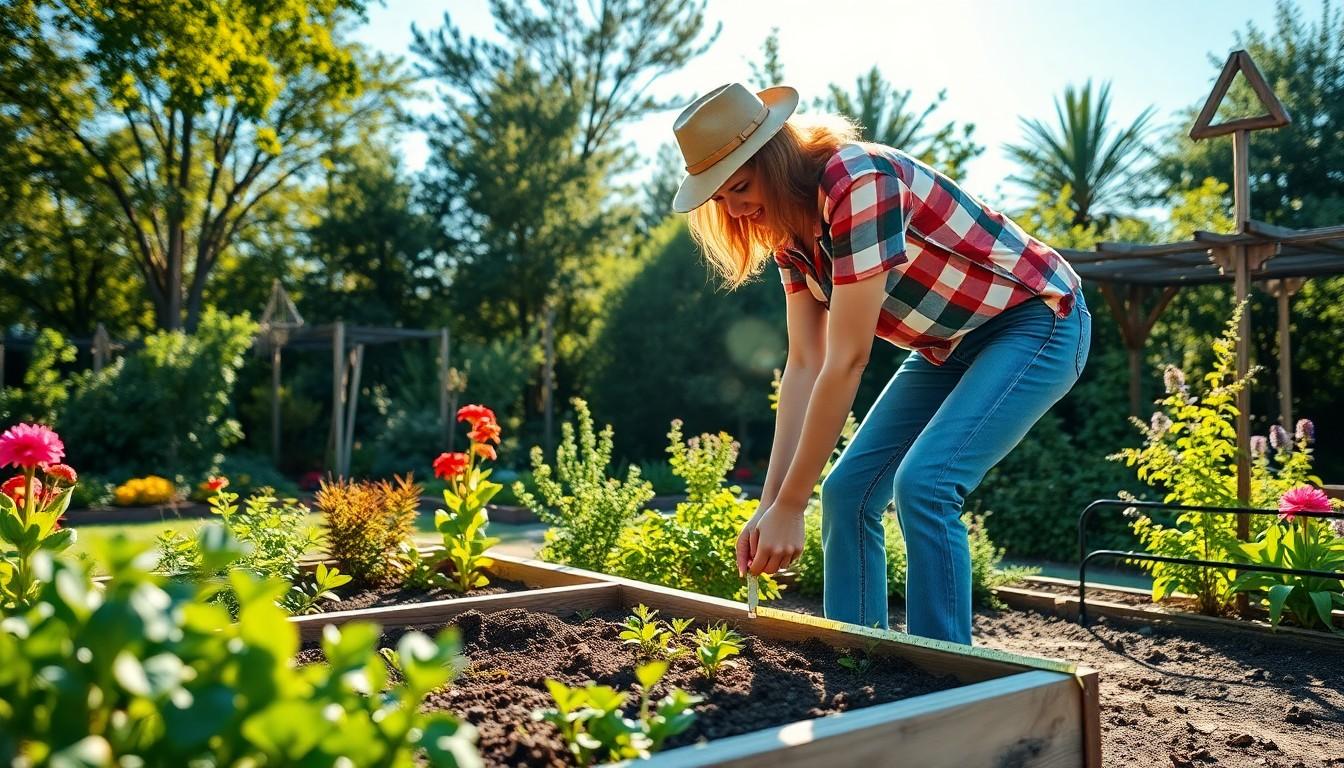Planning a garden layout might sound like a stroll in the park, but it’s more like trying to solve a Rubik’s Cube while blindfolded. With a little creativity and some strategic thinking, anyone can transform their outdoor space into a blooming paradise. Imagine stepping outside to a vibrant oasis filled with colorful flowers and delicious veggies—sounds dreamy, right?
Planning a Garden Layout
Planning a garden layout serves as a foundation for a successful garden. It facilitates organized placement of plants and flowers while considering their sunlight and water needs. Effective layout design maximizes available space, ensuring plant growth thrives harmoniously.
Creating a visual representation of the garden helps in understanding dimensions and shapes, assisting in avoiding overcrowding. Planning ahead provides an opportunity to incorporate pathways and seating areas, enhancing functionality.
In addition, a thoughtful layout accounts for seasonal changes, allowing for crop rotation and a continuous display of color throughout the year. Recognizing which plants complement each other promotes healthy growth and minimizes pest issues.
Utilizing techniques such as companion planting fosters sustainability, enhancing the garden’s ecosystem. Anticipating growth patterns enables gardeners to select appropriate spacing for each plant, reducing maintenance efforts.
Lastly, prioritizing aesthetics transforms the space into a captivating experience, drawing visitors and creating a welcoming atmosphere. Aligning the garden’s purpose with its design, whether for relaxation or productivity, results in a balanced outdoor environment.
Key Elements of Garden Layout Planning

Effective garden layout planning focuses on maximizing space, ensuring aesthetic appeal, and fostering plant health.
Assessing Your Space
Start by evaluating the available area. Consider the amount of sunlight that different parts of the garden receive throughout the day. Measure the dimensions accurately, noting any features like trees, fences, or structures that may influence plant growth. Identify any existing soil types and drainage conditions, as these factors can impact plant health. Map out the space, creating a visual representation that highlights both sunny and shady areas. This assessment allows for informed decisions on plant placement, optimizing your garden’s overall potential.
Choosing the Right Plants
Focus on selecting plants suited to your specific environment. Identify plants that thrive in your climate zone, considering factors like temperature and humidity. Look for plants with compatible water and sunlight requirements to ensure healthy growth. Balance perennials and annuals for year-round interest, and incorporate native species to promote biodiversity. Group plants with similar needs to streamline maintenance, allowing for efficient watering and care routines. Prioritize color and texture to create visual harmony, ensuring an appealing garden layout that mirrors your vision and goals.
Design Principles for Effective Garden Layouts
Effective garden layouts incorporate design principles that enhance both aesthetics and functionality. Utilizing these principles ensures a harmonious outdoor space.
Balance and Symmetry
Balance in garden design creates a sense of stability. Plant distribution should occur evenly across the space, preventing any side from feeling too heavy or overcrowded. Symmetrical arrangements, such as mirrored planting on either side of a path, evoke tranquility. Designers can also achieve asymmetrical balance by varying plant heights and types while keeping visual weight equal. Another element of balance involves considering both focal points and surrounding areas, ensuring attention draws evenly across the landscape. Emphasizing focal points, like a sculpture or ornamental tree, significantly enhances visual interest when strategically placed.
Color and Texture
Color choices play a crucial role in garden appeal. Combining complementary colors sparks energy and excitement. Gardeners can use color wheels as a guide when selecting plant palettes, considering seasonal blooms for continuous interest. Texture adds depth to the layout. Pairing fine-textured plants, such as ornamental grasses, with bold-textured plants like succulents creates contrast. Mixing leaf shapes and sizes heightens intrigue across the garden. Additionally, including plants with varied bloom times promotes a dynamic visual experience, especially in perennial gardens. Engaging multiple visual elements creates a vibrant atmosphere, attracting visitors year-round.
Common Mistakes to Avoid in Garden Layouts
Ignoring plant spacing often leads to overcrowding, which hampers growth. Each plant needs adequate space to thrive, ensuring proper air circulation and nutrient access. Overestimating sunlight exposure frequently results in poor plant performance. Plant heights and foliage density must align with sunlight requirements, creating an even distribution of light.
Neglecting soil quality can drastically affect plant health. Testing soil composition allows gardeners to make informed amendments, optimizing growth conditions. Failing to plan for growth can lead to future layout adjustments. Anticipating the full size of plants ensures long-term compatibility within the garden space.
Using a single plant variety reduces biodiversity and increases susceptibility to pests. Incorporating a mix of species can create a more resilient ecosystem. Disregarding seasonal changes often causes mismatched plant selections. Selecting plants that bloom at different times maintains visual interest throughout the year.
Skipping a visual plan may result in chaotic layouts. Utilizing design sketches helps visualize placements and identify potential issues before planting. Ignoring maintenance needs can complicate upkeep. Choosing low-maintenance plants can minimize effort while preserving aesthetic appeal.
Overlooking pathways can restrict access and hinder garden enjoyment. Creating pathways enhances navigation and accessibility. Misjudging water requirements can lead to under or over-watering. Researching the specific watering needs of each plant is essential for a thriving garden.
Lastly, failing to evaluate the garden’s purpose can undermine the design strategy. Consideration of whether the space serves relaxation, productivity, or entertainment shapes layout decisions. Prioritizing these aspects sets the foundation for a successful garden layout, avoiding common pitfalls and fostering a vibrant outdoor environment.
Enjoyment and Relaxation
Planning a garden layout is an exciting journey that transforms outdoor spaces into thriving ecosystems. By embracing creativity and strategic thinking, gardeners can overcome challenges and design areas that are both beautiful and functional.
Prioritizing plant health and aesthetic appeal ensures a vibrant garden that flourishes year-round. With careful consideration of sunlight, water needs, and seasonal changes, each garden can become a unique sanctuary.
Avoiding common mistakes and incorporating diverse plant varieties will enhance the garden’s resilience and visual interest. Ultimately, a well-planned garden layout not only reflects personal style but also fosters a harmonious environment that invites enjoyment and relaxation.

